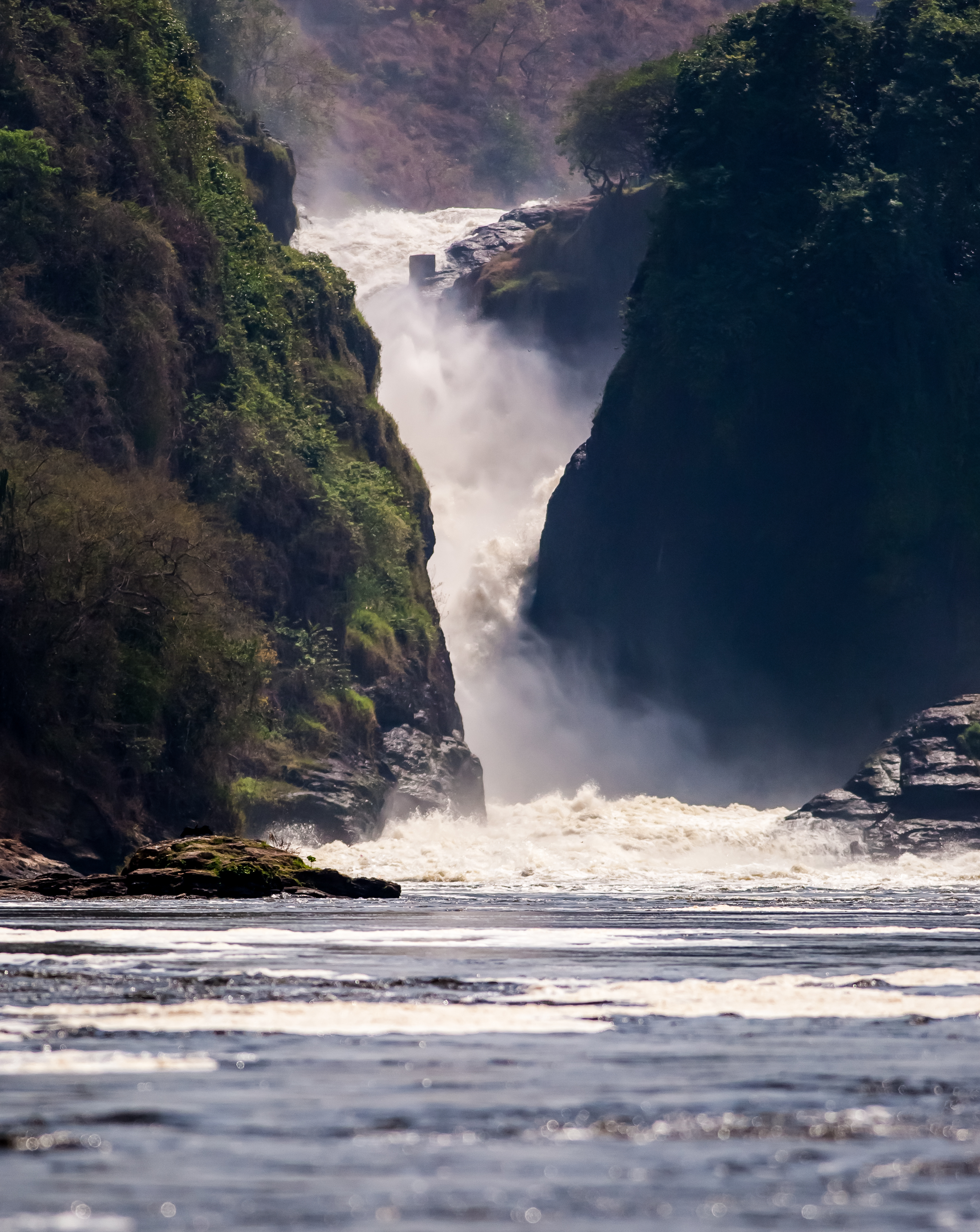Murchison Falls
In his book, The Albert N’Yanza, Great Basin of the Nile, And Explorations of the Nile (original edition published by Macmillan and Co. in London, 1866) Sir Samuel White Baker describes his first view of the falls thus: “Upon rounding the corner, a magnificent sight burst suddenly upon us. On either side the river were beautifully wooded cliffs rising abruptly to a height of about 300 feet; rocks were jutting out from the intensely green foliage; and rushing through a gap that cleft the rock exactly before us, the river, contracted from a grand stream, was pent up in a narrow gorge of scarcely fifty yards in width; roaring furiously through the rock-bound pass, it plunged in one leap of about 120 feet perpendicular into a dark abyss below. The fall of water was snow white, which had a superb effect as it contrasted with the dark cliffs that walled the river, while the graceful palms of the tropics and wild plantains perfected the beauty of the view. This was the greatest waterfall of the Nile, and, in honour of the distinguished President of the Royal Geographical Society, I named it the Murchison Falls, as the most important object throughout the entire course of the river.”
You can get his book by clicking on this image →
Murchison Falls was thus named after Sir Roderick Impey Murchison, a founder and President of the Royal Geographical Society, and a prominent geologist who had theorized that the Nile was fed by a chain of lakes on an elevated plateau in Central Africa. Various explorers, including Baker, Speke, Burton, Livingstone, and Stanley are part of this story. Although Churchill is widely believed to have coined the phrase “The Pearl of Africa” to describe Uganda, it was apparently Henry Morton Stanley who first used the phrase, as mentioned in Lugard’s book “The Rise of Our East African Empire”.
Churchill merely stated in his book “My African Journey” that “… it is not possible to descend the Nile continuously from its source at Ripon Falls without realizing that the best lies behind one. Uganda is the pearl.”
This is likely an acknowledgement by Churchill of Stanley’s description of Uganda as “The Pearl of Africa”.
A good reference book for this era of exploration of the source of the Nile is Tim Jeal’s “Explorers of the Nile: The Triumph and Tragedy of a Great Victorian Adventure”
Below is a photograph I took in 2008, which is the view Baker was describing in 1864.
Satellite view of Murchison Falls
(this is an interactive view and can be set to different magnification levels by clicking on the + or – buttons on the map or by double-clicking on the map or using your mouse wheel)
The concrete post shown here was part of the iron footbridge that crossed the chasm at its narrowest point (widely reported to have been built in 1960, but I recall having seen it on my first trip to the falls as a child in 1954. It was Churchill who thought there should be a bridge on this spot in 1909. In his book “My African Journey” he states: “The narrowness of the gorge at the top had not been overstated. I doubt whether it is fifteen feet across from sheer rock to sheer rock. Ten pounds, in fact, would throw an iron bridge across the Nile at this point.”
Churchill also mused about hydroelectric power generation using the force of the falls. Thank God that has not happened yet. The falls remains as it was when Baker saw it.
There is a short article in the Sarasota Herald Tribune dated March 28, 1954 that mentions the bridge being built by African engineering students with the headline “Footbridge for elephants built on Nile”. A similar article appeared in the Herald Journal on March 28, 1954 and the Daily Reporter on March 25, 1954, so it is likely the bridge was completed in 1954) but the bridge was washed away during the rains one year (often reported to have occurred in 1962, but this might also be inaccurate as I remember visiting the site in 1967 and the bridge was still there. On my 2008 visit (the year of this photograph) it was gone. Perhaps it had been rebuilt after 1962 and washed away again after I left Uganda in October 1972. Two lakes, Victoria and Kyoga drain into Nile, forming rapids that finally plunge 141 feet over Murchison falls into the “Devil’s Cauldron” below and eventually reach Lake Albert. The volume per second is estimated at 300 cubic metres per second (79,251.6 US gallons per second). The thunderous roar is unimaginable. The falls was the backdrop to a scene in “The African Queen”, a John Huston directed movie starring Humphrey Bogart (who got the Oscar for Best Actor) and Katherine Hepburn.
Another event in the history of the falls was the miraculous survival of Ernest Hemingway and his wife Mary when they were involved in two different plane crashes on the same day on their trip to the falls in January 1954.








